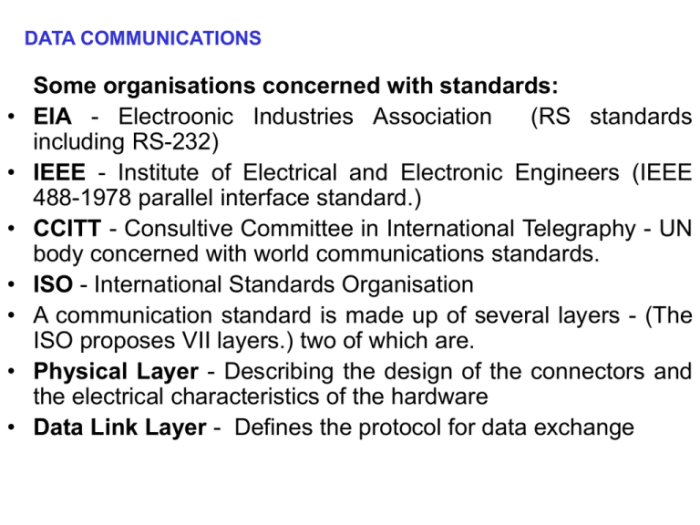
Embark on a journey through the intricate world of data communication standards and regulations, where the importance of compliance meets the need for robust security measures.
From understanding the significance of adherence to exploring the consequences of non-compliance, this topic delves into a realm where rules shape the digital landscape.
Data Communication Standards and Regulations

In the fast-paced world of technology, adhering to data communication standards and regulations is crucial to ensure smooth and secure transfer of information. These standards provide a common framework for devices and systems to communicate effectively and efficiently.
Importance of Adhering to Data Communication Standards
Adhering to data communication standards is essential to ensure interoperability between different systems and devices. It allows for seamless data exchange, improved efficiency, and enhanced security. By following these standards, organizations can avoid compatibility issues and reduce the risk of data breaches.
Examples of Common Data Communication Standards and Regulations
- IEEE 802.11 – Wireless LAN Standards
- ISO/IEC 27001 – Information Security Management
- HIPAA – Health Insurance Portability and Accountability Act
- GDPR – General Data Protection Regulation
Potential Consequences of Not Following Data Communication Regulations
Failure to comply with data communication regulations can lead to severe consequences, including legal penalties, loss of customer trust, and damage to the organization’s reputation. Data breaches, unauthorized access, and data loss are just some of the risks associated with non-compliance.
Comparison of Different Data Communication Standards in Various Industries
| Industry | Common Data Communication Standards |
|---|---|
| Healthcare | HIPAA, HL7 |
| Finance | PCI DSS, SWIFT |
| Telecommunications | ITU-T, 3GPP |
Electronics and Electrical
Electronics play a crucial role in data communication standards, as they involve the design and implementation of devices that facilitate the transmission and reception of data.
Electrical systems impact data transmission by providing the necessary power and signal pathways for electronic devices to function effectively. The quality and efficiency of electrical systems directly influence the speed and reliability of data transfer.
Electronic Devices for Data Communication Compliance
- Modems: These devices modulate and demodulate signals to enable digital data to be transmitted over analog communication lines, ensuring compatibility with data communication standards.
- Firewalls: Electronic firewall systems are used to monitor and control incoming and outgoing network traffic to protect against unauthorized access and ensure data security compliance.
- Encryption Devices: Hardware encryption devices are employed to encode data before transmission and decode it upon reception, safeguarding sensitive information in accordance with data communication regulations.
The relationship between electronics, electrical systems, and data security is intertwined, as the proper functioning of electronic devices relies on efficient electrical systems to maintain data integrity and confidentiality. Compliance with data communication regulations often requires the use of specific electronic devices designed to address security concerns and ensure data protection.
Computer Repair and Consulting

When it comes to computer repair and consulting, data communication standards play a crucial role in ensuring the security and reliability of information exchange. Technicians and consultants must adhere to these standards to prevent data breaches and maintain the integrity of communication systems.
Influence of Data Communication Standards on Computer Repair Practices
Data communication standards influence computer repair practices by setting guidelines for handling and transferring data securely. Technicians must ensure that all repairs and maintenance work comply with these standards to protect sensitive information and prevent unauthorized access.
- Use encrypted communication protocols to safeguard data during repairs.
- Regularly update software and firmware to address security vulnerabilities.
- Implement access controls to restrict unauthorized users from tampering with sensitive data.
Best Practices for Consultants to Ensure Adherence to Data Communication Regulations
Consultants can ensure adherence to data communication regulations by keeping up-to-date with the latest standards and guidelines. It is essential to educate clients on the importance of compliance and implement protocols to maintain data security.
- Provide regular training to staff on data communication standards and best practices.
- Conduct regular audits to assess compliance with regulations and identify areas for improvement.
- Establish clear policies and procedures for handling sensitive data to prevent breaches.
Challenges Faced by Computer Repair Professionals in Maintaining Data Security Standards
Computer repair professionals face challenges in maintaining data security standards due to evolving cyber threats and complex communication systems. It is vital to address these challenges proactively to safeguard data and prevent security breaches.
- Difficulty in detecting and mitigating advanced cyber threats that target communication networks.
- Ensuring compatibility of repair solutions with existing data communication protocols.
- Balancing the need for efficient repairs with stringent security measures to prevent data loss.
Tips for Computer Repair Technicians to Troubleshoot Issues Related to Data Communication Standards
Computer repair technicians can troubleshoot issues related to data communication standards effectively by following best practices and utilizing specialized tools. It is essential to identify and resolve communication problems promptly to maintain the integrity of data exchange.
- Utilize network monitoring tools to diagnose and resolve communication issues in real-time.
- Verify proper configuration of communication devices to ensure seamless data transfer.
- Collaborate with network engineers and IT professionals to address complex data communication issues effectively.
Computers E-Books
E-books have become a popular format for reading and accessing information in the digital age. Let’s explore how data communication standards and regulations impact the world of e-books.
Impact of Data Communication Standards on E-Books
Data communication standards play a crucial role in ensuring that e-books are transmitted efficiently and securely across networks. By adhering to these standards, e-book platforms can guarantee that users receive their content in a consistent and reliable manner.
- Standardized formats such as EPUB and PDF make it easier for e-books to be accessed on a variety of devices.
- Compliance with communication protocols like HTTP and FTP enables seamless downloading of e-books from online platforms.
Role of Data Encryption in Protecting E-Book Content
Data encryption plays a vital role in safeguarding the content of e-books during transmission. By encrypting e-book files, platforms can ensure that sensitive information remains secure and protected from unauthorized access.
-
Encryption algorithms like AES and RSA are used to encode e-book data, making it unreadable to anyone without the decryption key.
- Secure transmission protocols like HTTPS add an extra layer of protection when e-books are being downloaded or accessed online.
Impact of Data Communication Regulations on E-Book Distribution
Data communication regulations can significantly impact the distribution of e-books, particularly in terms of privacy, copyright, and accessibility. Platforms must comply with these regulations to ensure that e-book distribution is done legally and ethically.
- Regulations like the GDPR in Europe require e-book platforms to obtain user consent before collecting and processing personal data.
- Copyright laws dictate how e-books can be shared, distributed, and accessed to protect the rights of authors and publishers.
E-Book Platforms Prioritizing Data Security
Several e-book platforms prioritize data security and compliance to ensure that users can access e-books safely and securely. These platforms implement robust security measures to protect user data and uphold data communication standards.
- Amazon Kindle encrypts e-book files and implements DRM (Digital Rights Management) to prevent unauthorized sharing and distribution.
- Apple Books uses end-to-end encryption to protect user information and e-book content from potential threats.
Graphics and Multimedia
Data communication standards play a crucial role in the transmission of graphics and multimedia files. These standards ensure that the data is transmitted efficiently and accurately across different networks and devices.Multimedia content creators can ensure compliance with data communication regulations by following specific guidelines and protocols set by standardization bodies. By adhering to these regulations, creators can guarantee the seamless transfer of multimedia content without any loss of quality or data.
Impact of Data Communication Standards on Graphics and Multimedia Transmission
- Data communication standards help in maintaining the quality of graphics and multimedia files during transmission.
- Standards ensure compatibility between different devices and networks, allowing for smooth transfer of multimedia content.
- By following standardized protocols, data communication standards help in reducing errors and packet loss in graphics and multimedia transmission.
Common Data Formats for Graphics and Multimedia Transmission
- JPEG (Joint Photographic Experts Group): widely used for compressing and transmitting images.
- MP4 (MPEG-4 Part 14): a popular format for storing video and audio files.
- GIF (Graphics Interchange Format): commonly used for animated images and graphics.
Strategies for Optimizing Data Transfer Speed
- Use efficient compression techniques to reduce the size of graphics and multimedia files before transmission.
- Implement caching mechanisms to store frequently accessed multimedia content for faster retrieval.
- Utilize content delivery networks (CDNs) to distribute multimedia content across geographically dispersed servers for quicker access.
Computers Hardware
Hardware components play a crucial role in maintaining data communication standards by providing the necessary infrastructure for transmitting and receiving data efficiently.
Significance of Hardware Components
- Network Interface Cards (NICs) help establish connections between devices and networks, ensuring smooth data transmission.
- Routers and switches manage the flow of data packets, directing them to their intended destinations accurately.
- Cables and connectors maintain physical connections, preventing data loss or interference during transmission.
Hardware Compatibility and Data Transmission Efficiency
- Compatible hardware ensures seamless communication between devices, leading to faster data transmission and reduced latency.
- Mismatched hardware can cause data transmission errors, delays, and even network disruptions, impacting communication efficiency.
Role of Hardware Drivers
- Hardware drivers act as software interfaces between the operating system and hardware components, ensuring proper functionality and compatibility.
- Regular updates and installations of hardware drivers help maintain compliance with data communication regulations and standards.
Hardware Upgrades for Enhanced Performance
- Upgrading to faster processors and additional RAM can improve data processing speed and overall system performance.
- Installing solid-state drives (SSDs) instead of traditional hard drives can significantly reduce data access times and enhance data communication efficiency.
- Upgrading network hardware, such as routers and switches, to models with higher data transfer speeds can optimize network performance for data transmission.
Last Point
As we conclude this discussion, remember that adherence to data communication standards is not just a choice but a necessity in today’s interconnected world. Stay compliant, stay secure.
Query Resolution
What are some common data communication standards?
Common data communication standards include TCP/IP, Ethernet, and Wi-Fi protocols.
Why is it important to follow data communication regulations?
Following data communication regulations ensures secure and efficient data transmission, protecting sensitive information.
How do data communication standards impact computer repair practices?
Data communication standards influence computer repair by requiring technicians to troubleshoot network-related issues effectively.







